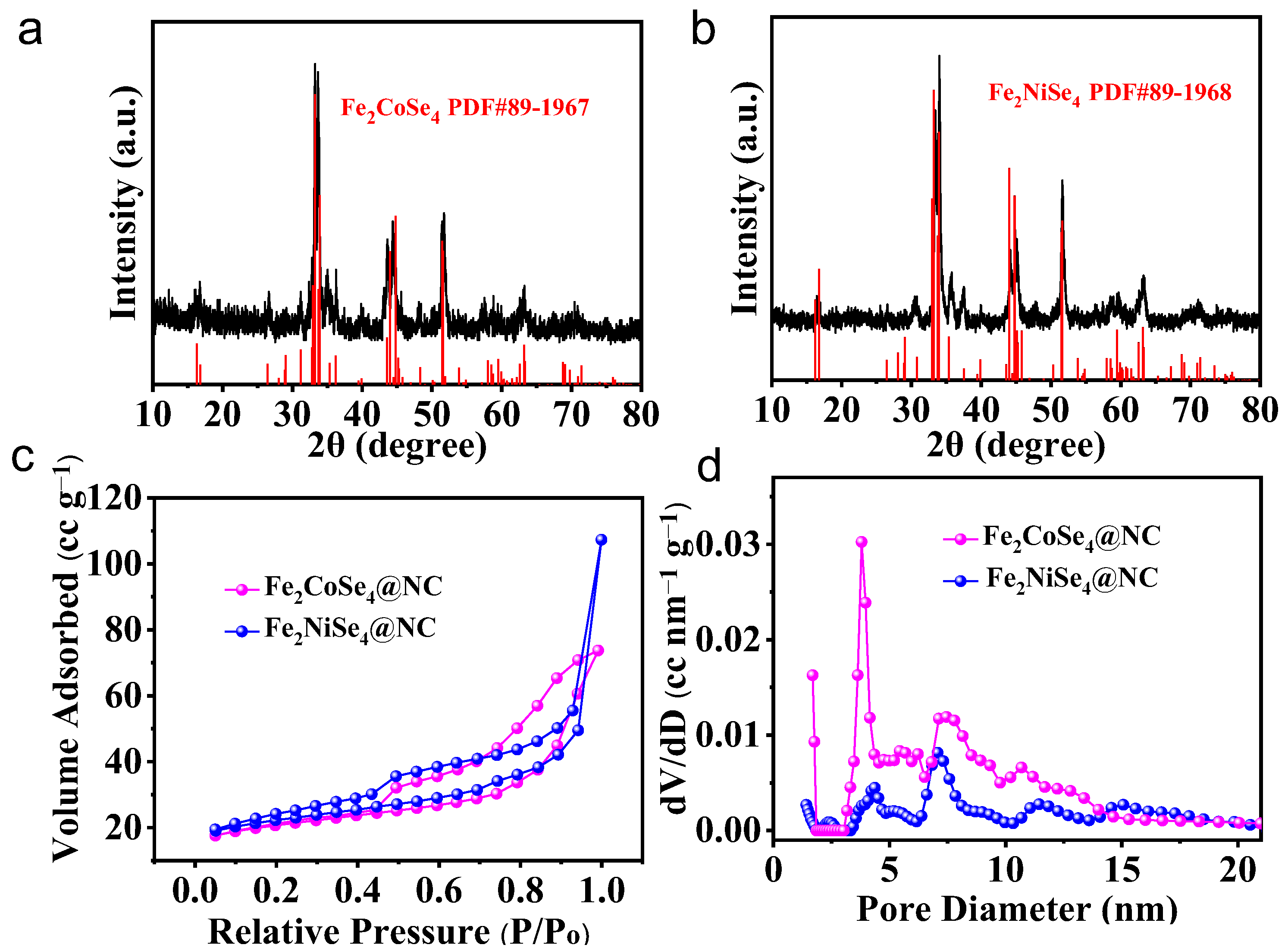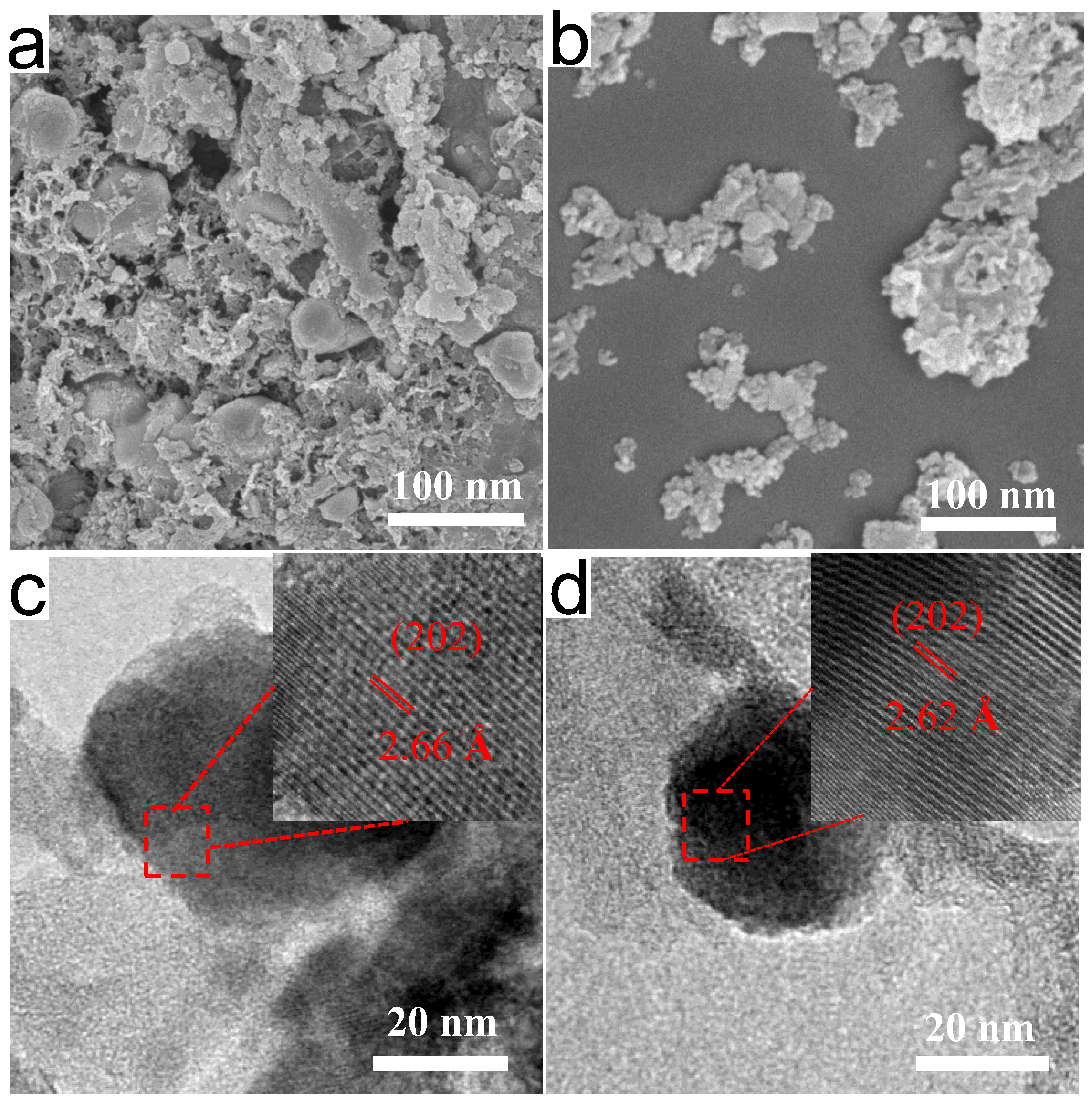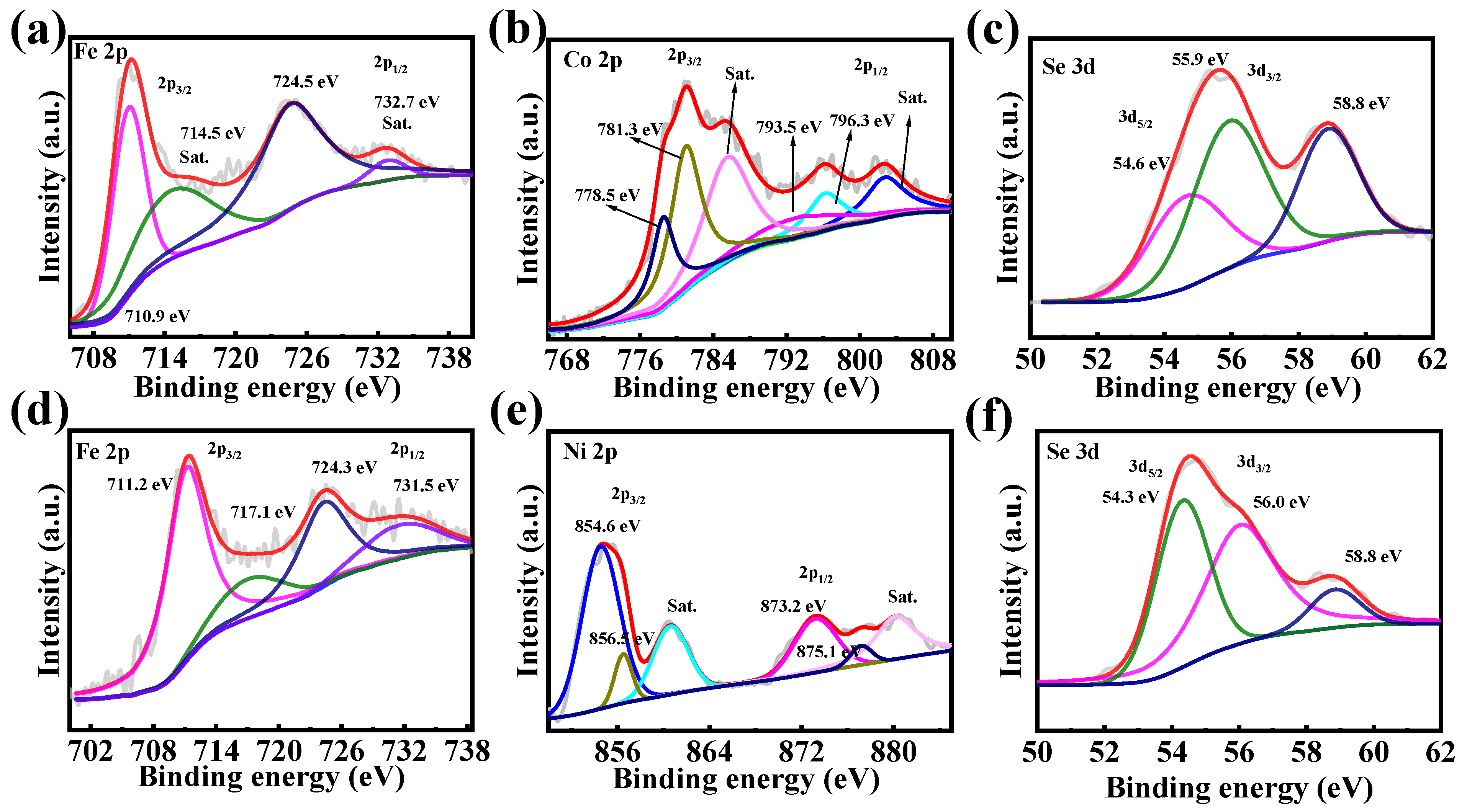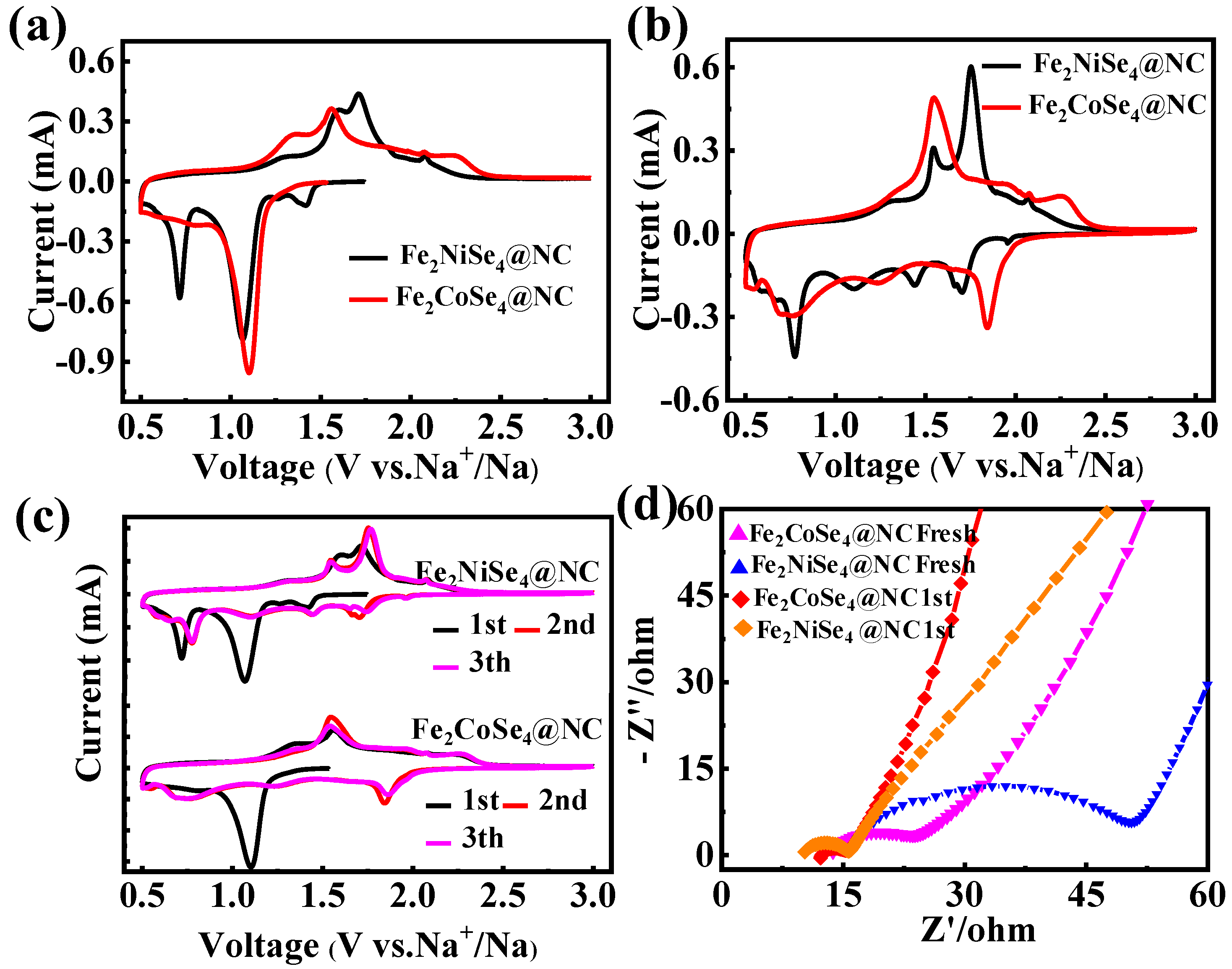MOF-Derived Fe2CoSe4@NC and Fe2NiSe4@NC Composite Anode Materials towards High-Performance Na-Ion Storage
Abstract
1. Introduction
2. Results
- Discharge procedure of Fe2CoSe4@NC:Fe2CoSe4 + xNa+ + xe− → NaxFe2CoSe4NaxFe2CoSe4 + 2yNa+ + 2ye− → NaxFe2CoSe4−y + yNa2SeNaxFe2CoSe4−y + (8 − 2y − x)Na+ + (8 − 2y − x) e−
→ 2Fe + Co + (4 − y) Na2Se
- Discharge procedure of Fe2NiSe4@NC:Fe2 NiSe4 + xNa+ + xe− → NaxFe2NiSe4NaxFe2NiSe4 + (2 − x)Na+ + (2 − x)e− → 2FeSe + NiSe + Na2Se2FeSe + 4Na+ + 4e− → 2Fe + 2Na2SeNiSe + 2Na+ + 2e− → Ni + Na2Se
3. Materials and Methods
3.1. Chemicals
3.2. Synthesis of FeCo-MOFs and FeNi-MOFs
3.3. Synthesis of Fe2CoSe4@NC and Fe2NiSe4@NC
3.4. Materials Characterization
3.5. Coin Cell Assembly
3.6. Electrochemical Measurements
4. Conclusions
Supplementary Materials
Author Contributions
Funding
Data Availability Statement
Conflicts of Interest
References
- Zhao, Y.; Kang, Y.; Wozny, J.; Lu, J.; Du, H.; Li, C.; Li, T.; Kang, F.; Tavajohi, N.; Li, B. Recycling of sodium-ion batteries. Nature Rev. Mater. 2023, 8, 623–634. [Google Scholar] [CrossRef]
- Jia, M.; Jin, Y.; Zhao, P.; Zhao, C.; Jia, M.; Wang, L.; He, X. Hollow NiCoSe2 microspheres@N-doped carbon as high-performance pseudocapacitive anode materials for sodium ion batteries. Electrochim. Acta 2019, 310, 230–239. [Google Scholar] [CrossRef]
- Su, Q.; Cao, X.; Yu, T.; Kong, X.; Wang, Y.; Chen, J.; Lin, J.; Xie, X.; Liang, S.; Pan, A. Binding MoSe2 with dual protection carbon for high-performance sodium storage. J. Mater. Chem. A 2019, 7, 22871–22878. [Google Scholar] [CrossRef]
- Wang, B.; Chen, K.; Wang, G.; Liu, X.; Wang, H.; Bai, J. A multidimensional and hierarchical carbon-confined cobalt phosphide nanocomposite as an advanced anode for lithium and sodium storage. Nanoscale 2019, 11, 968–985. [Google Scholar] [CrossRef] [PubMed]
- Wei, D.; Xu, F.; Xu, J.; Fang, J.; Sun, Z. Rambutan-pitaya-like structured TiO2@Co-CNT-NC nanocomposite as high-performance lithium ion battery anodes. Ceram. Int. 2019, 45, 22131–22137. [Google Scholar] [CrossRef]
- Yin, X.; Zhao, Y.; Zhang, J. Research Progress and Performance Improvement Strategies of Hard Carbon Anode Materials for Sodium-Ion Batteries. J. Electrochem. 2023, 29, 2204301. [Google Scholar] [CrossRef]
- Chen, Y.C.; Yang, M.L.; Yang, L.T.; Chen, Z.W.; Li, H.Y.; Woo, H.J.; Chi, S.S.; Xiao, Y.G.; Wang, J.; Wang, C.Y.; et al. Alkali and alkaline ions co-substitution of P2 sodium layered oxides for sodium ion batteries. Chin. J. Struct. Chem. 2023, 42, 100028. [Google Scholar] [CrossRef]
- Ali, Z.; Asif, M.; Huang, X.; Tang, T.; Hou, Y. Hierarchically Porous Fe2CoSe4 Binary-Metal Selenide for Extraordinary Rate Performance and Durable Anode of Sodium-Ion Batteries. Adv. Mater. 2018, 30, 1802745. [Google Scholar] [CrossRef]
- Leibing, C.; Leistenschneider, D.; Neumann, C.; Oschatz, M.; Turchanin, A.; Balducci, A. Glyoxylic-Acetal-Based Electrolytes for Sodium-Ion Batteries and Sodium-Ion Capacitors. ChemSusChem 2023, 16, e202300161. [Google Scholar] [CrossRef]
- Zhang, L.; Li, X.; Yang, M.; Chen, W. High-safety separators for lithium-ion batteries and sodium-ion batteries: Advances and perspective. Energy Storage Mater. 2021, 41, 522–545. [Google Scholar] [CrossRef]
- Miao, K.; Jiang, W.; Chen, Z.; Luo, Y.; Xiang, D.; Wang, C.; Kang, X. Hollow-Structured and Polyhedron-Shaped High Entropy Oxide toward Highly Active and Robust Oxygen Evolution Reaction in a Full pH Range. Adv. Mater. 2024, 36, 2308490. [Google Scholar] [CrossRef] [PubMed]
- Fan, Y.; Chang, Z.; Wu, Z.; Feng, Y.; Du, X.; Che, M.; Tian, J.; Xie, W.; Zhang, K. Nano-Confined Electrolyte for Sustainable Sodium-Ion Batteries. Adv. Funct. Mater. 2024, 34, 2314288. [Google Scholar] [CrossRef]
- Zhu, W.; Mao, Q.; Jia, Y.; Ni, J.; Gao, L. Dual-Carbon-Decorated Na3V2(PO4)3 Material for Sodium-Ion Batteries. J. Electron. Mater. 2023, 52, 836–846. [Google Scholar] [CrossRef]
- Chen, Y.; Xu, Y.; Sun, X.; Zhang, B.; He, S.; Li, L.; Wang, C. Preventing structural degradation from Na3V2(PO4)3 to V2(PO4)3: F-doped Na3V2(PO4)3/C cathode composite with stable lifetime for sodium ion batteries. J. Power Sources 2018, 378, 423–432. [Google Scholar] [CrossRef]
- Sam Oh, J.A.; Sun, Q.; Tian, C.; Song, X.; Chua, B.; Zeng, K.; Lu, L. Aerosol-deposited freestanding Na3V2(PO4)3 thin-film microbattery. Mater. Today Energy 2022, 27, 101006. [Google Scholar] [CrossRef]
- Du, J.; Zou, Z.; Liu, C.; Xu, C. Hierarchical Fe-doped Ni3Se4 ultrathin nanosheets as an efficient electrocatalyst for oxygen evolution reaction. Nanoscale 2018, 10, 5163–5170. [Google Scholar] [CrossRef] [PubMed]
- Shen, L.; Li, Y.; Hu, C.; Huang, Z.; Wang, B.; Wang, Y.; Liu, Q.; Ye, F. A high-rate cathode material based on potassium-doped Na3V2(PO4)3 for high/low-temperature sodium-ion batteries. Mater. Today Chem. 2023, 30, 101506. [Google Scholar] [CrossRef]
- Liu, J.; Xie, J.; Dong, H.; Wei, H.; Sun, C.; Yang, J.; Geng, H. Iron doping of NiSe2 nanosheets to accelerate reaction kinetics in sodium-ion half/full batteries. Sci. China Mater. 2023, 66, 69–78. [Google Scholar] [CrossRef]
- Niu, F.; Yang, J.; Wang, N.; Zhang, D.; Fan, W.; Yang, J.; Qian, Y. MoSe2-Covered N,P-Doped Carbon Nanosheets as a Long-Life and High-Rate Anode Material for Sodium-Ion Batteries. Adv. Funct. Mater. 2017, 27, 1700522. [Google Scholar] [CrossRef]
- Hussain, I.; Sahoo, S.; Lamiel, C.; Nguyen, T.T.; Ahmed, M.; Xi, C.; Iqbal, S.; Ali, A.; Abbas, N.; Javed, M.S.; et al. Research progress and future aspects: Metal selenides as effective electrodes. Energy Storage Mater. 2022, 47, 13–43. [Google Scholar] [CrossRef]
- Fang, S.; Bresser, D.; Passerini, S. Transition Metal Oxide Anodes for Electrochemical Energy Storage in Lithium- and Sodium-Ion Batteries. Adv. Energy Mater. 2020, 10, 1902485. [Google Scholar] [CrossRef]
- Wu, H.; Yuan, R.; Li, M.; Liu, L.; Liu, Y.; Song, Q.; Ai, W.; Du, H.; Du, Z.; Wang, K. Co0.85Se–Fe7Se8 nanocuboids embedded in reduced graphene oxides as cycle-stable anodes for sodium-ion batteries. Carbon 2022, 198, 171–178. [Google Scholar] [CrossRef]
- Zhang, Z.; Sun, S.; Chen, Y.; Wei, Y.; Zhang, M.; Li, C.; Sun, Y.; Zhang, S.; Jiang, Y. Epitaxial growth of Cu2-xSe on Cu (220) crystal plane as high property anode for sodium storage. Chin. Chem. Lett. 2023, 35, 108922. [Google Scholar] [CrossRef]
- Wang, S.; Xu, B.; Huo, W.; Feng, H.; Zhou, X.; Fang, F.; Xie, Z.; Shang, J.K.; Jiang, J. Efficient FeCoNiCuPd thin-film electrocatalyst for alkaline oxygen and hydrogen evolution reactions. Appl. Catal. B Environ. 2022, 313, 121472. [Google Scholar] [CrossRef]
- Ali, Z.; Asif, M.; Zhang, T.; Huang, X.; Hou, Y. General Approach to Produce Nanostructured Binary Transition Metal Selenides as High-Performance Sodium Ion Battery Anodes. Small 2019, 15, 1901995. [Google Scholar] [CrossRef]
- Huang, X.; Men, S.; Zheng, H.; Qin, D.-D.; Kang, X. Highly Porous NiCoSe4 Microspheres as High-Performance Anode Materials for Sodium-Ion Batteries. Chem. -Asian J. 2020, 15, 1456–1463. [Google Scholar] [CrossRef] [PubMed]
- Huang, F.; Wang, L.; Qin, D.C.; Xu, Z.B.; Jin, M.Q.; Chen, Y.; Zeng, X.X.; Dai, Z.H. Constructing Heterostructured Bimetallic Selenides on an N-Doped Carbon Nanoframework as Anodes for Ultrastable Na-Ion Batteries. ACS Appl. Mater. Interf. 2022, 14, 1222–1232. [Google Scholar] [CrossRef] [PubMed]
- Men, S.; Lin, J.; Zhou, Y.; Kang, X. N-doped porous carbon wrapped FeSe2 nanoframework prepared by spray drying: A potential large-scale production technique for high-performance anode materials of sodium ion batteries. J. Power Sources 2021, 485, 229310. [Google Scholar] [CrossRef]
- Zhu, J.; Chen, X.; Zhang, L.; Wang, Q.; Yang, J.; Geng, H. Structural engineering of bimetallic selenides for high-energy density sodium-ion half/full batteries. Dalton Trans. 2022, 51, 16898–16905. [Google Scholar] [CrossRef]
- Yu, L.; Zhou, H.; Sun, J.; Qin, F.; Yu, F.; Bao, J.; Yu, Y.; Chen, S.; Ren, Z. Cu nanowires shelled with NiFe layered double hydroxide nanosheets as bifunctional electrocatalysts for overall water splitting. Energy Environ. Sci. 2017, 10, 1820–1827. [Google Scholar] [CrossRef]
- Lin, J.J.; Zhou, Y.; Wen, J.B.; Si, W.J.; Gao, H.C.; Wang, G.M.; Kang, X.W. Pyrrole derivatives as interlayer modifier of Li-S batteries: Modulation of electrochemical performance by molecular perturbation. J. Energy Chem. 2022, 75, 164–172. [Google Scholar] [CrossRef]
- Wan, R.; Luo, M.; Wen, J.; Liu, S.; Kang, X.; Tian, Y. Pt-Co single atom alloy catalysts: Accelerated water dissociation and hydrogen evolution by strain regulation. J. Energy Chem. 2022, 69, 44–53. [Google Scholar] [CrossRef]
- Zhang, B.; Luo, Y.; Xiang, D.; Qin, J.; Miao, K.; Wang, X.; Kang, X.; Tian, Y. Yolk-Shell Structured Zinc-Cobalt-Ruthenium Alloy Oxide Assembled with Ultra-Small Nanoparticles: A Superior Cascade Catalyst toward Oxygen Evolution Reaction. Adv. Funct. Mater. 2023, 33, 2214529. [Google Scholar] [CrossRef]
- Muralee Gopi, C.V.V.; Reddy, A.E.; Kim, H.-J. Wearable superhigh energy density supercapacitors using a hierarchical ternary metal selenide composite of CoNiSe2 microspheres decorated with CoFe2Se4 nanorods. J. Mater. Chem. A 2018, 6, 7439–7448. [Google Scholar] [CrossRef]
- Wang, B.; Wang, Z.; Wang, X.; Zheng, B.; Zhang, W.; Chen, Y. Scalable synthesis of porous hollow CoSe2–MoSe2/carbon microspheres for highly efficient hydrogen evolution reaction in acidic and alkaline media. J. Mater. Chem. A 2018, 6, 12701–12707. [Google Scholar] [CrossRef]
- Park, J.-S.; Chan Kang, Y. Multicomponent (Mo, Ni) metal sulfide and selenide microspheres with empty nanovoids as anode materials for Na-ion batteries. J. Mater. Chem. A 2017, 5, 8616–8623. [Google Scholar] [CrossRef]
- He, Y.; Luo, M.; Dong, C.; Ding, X.; Yin, C.; Nie, A.; Chen, Y.; Qian, Y.; Xu, L. Coral-like NixCo1−xSe2 for Na-ion battery with ultralong cycle life and ultrahigh rate capability. J. Mater. Chem. A 2019, 7, 3933–3940. [Google Scholar] [CrossRef]
- Wang, Y.-Y.; Fan, H.; Hou, B.-H.; Rui, X.-H.; Ning, Q.-L.; Cui, Z.; Guo, J.-Z.; Yang, Y.; Wu, X.-L. Ni1.5CoSe5 nanocubes embedded in 3D dual N-doped carbon network as advanced anode material in sodium-ion full cells with superior low-temperature and high-power properties. J. Mater. Chem. A 2018, 6, 22966–22975. [Google Scholar] [CrossRef]
- Zhang, J.-Y.; Lv, L.; Tian, Y.; Li, Z.; Ao, X.; Lan, Y.; Jiang, J.; Wang, C. Rational Design of Cobalt–Iron Selenides for Highly Efficient Electrochemical Water Oxidation. ACS Appl. Mater. Interf. 2017, 9, 33833–33840. [Google Scholar] [CrossRef]
- Xiao, J.; Wan, L.; Yang, S.; Xiao, F.; Wang, S. Design Hierarchical Electrodes with Highly Conductive NiCo2S4 Nanotube Arrays Grown on Carbon Fiber Paper for High-Performance Pseudocapacitors. Nano Lett. 2014, 14, 831–838. [Google Scholar] [CrossRef]
- Shen, L.; Wang, J.; Xu, G.; Li, H.; Dou, H.; Zhang, X. NiCo2S4 Nanosheets Grown on Nitrogen-Doped Carbon Foams as an Advanced Electrode for Supercapacitors. Adv. Energy Mater. 2015, 5, 1400977. [Google Scholar] [CrossRef]
- Zhang, Z.; Huang, Y.; Liu, X.; Wang, X.; Liu, P. Core–Shell Co, Zn Bimetallic Selenide Embedded Nitrogen-Doped Carbon Polyhedral Frameworks Assist in Sodium-Ion Battery Ultralong Cycle. ACS Sustain. Chem. Eng. 2020, 8, 8381–8390. [Google Scholar] [CrossRef]
- Altaf, S.; Ajaz, H.; Imran, M.; Ul-Hamid, A.; Naz, M.; Aqeel, M.; Shahzadi, A.; Shahbaz, A.; Ikram, M. Synthesis and characterization of binary selenides of transition metals to investigate its photocatalytic, antimicrobial and anticancer efficacy. Appl. Nanosci. 2020, 10, 2113–2127. [Google Scholar] [CrossRef]
- Yu, W.; Kong, Y.; Lin, J.; Zheng, H.; Kang, X. Flower-like Spherical α-Ni(OH)2 Derived NiP2 as Superior Anode Material of Sodium-Ion Batteries. Chem. –Asian J. 2021, 16, 2100–2106. [Google Scholar] [CrossRef] [PubMed]
- Ma, C.; Qiu, L.; Bao, J.; Zhou, Y. Hexagonal FeNi2Se4@C Nanoflakes as High Performance Anode Materials for Sodium-ion Batteries. Chem. Res. 2021, 37, 318–322. (In Chinese) [Google Scholar] [CrossRef]
- Zhang, Y.; Liu, Y.; Lu, Y.; Yu, P.; Du, W.; Ma, B.; Xie, M.; Yang, H.; Cheng, T. Multi-Scale Simulation Revealing the Decomposition Mechanism of Electrolyte on Lithium Metal Electrode. J. Electrochem. 2022, 28, 2105181. [Google Scholar] [CrossRef]
- Choi, J.H.; Park, S.-K.; Kang, Y.C. A Salt-Templated Strategy toward Hollow Iron Selenides-Graphitic Carbon Composite Microspheres with Interconnected Multicavities as High-Performance Anode Materials for Sodium-Ion Batteries. Small 2019, 15, 1803043. [Google Scholar] [CrossRef]
- Hu, X.; Liu, X.; Chen, K.; Wang, G.; Wang, H. Core–shell MOF-derived N-doped yolk–shell carbon nanocages homogenously filled with ZnSe and CoSe2 nanodots as excellent anode materials for lithium- and sodium-ion batteries. J. Mater. Chem. A 2019, 7, 11016–11037. [Google Scholar] [CrossRef]
- Liang, Z.; Li, Q.; Zhang, W.; Yu, D.; Zhang, W.; Wu, J.; Wang, G.; Fan, W.; Wang, J.; Huang, S. Pomegranate-inspired porous SnSe/ZnSe@C anode: A stress-buffer nanostructure for fast and ultrastable sodium-ion storage. J. Energy Chem. 2022, 75, 369–377. [Google Scholar] [CrossRef]
- Zhou, P.; Zhang, M.; Wang, L.; Huang, Q.; Su, Z.; Xu, P.; Zou, R.; Wang, X.; Zeng, C.; Ba, K. MOFs-Derived Flower-like Hierarchically Porous Zn-Mn-Se/C Composite for Extraordinary Rate Performance and Durable Anode of Sodium-Ion and Potassium-Ion Batteries. Small 2022, 18, 2203964. [Google Scholar] [CrossRef]
- Huang, P.; Zhang, S.; Ying, H.; Zhang, Z.; Han, W. Few-layered Ti3C2 MXene anchoring bimetallic selenide NiCo2Se4 nanoparticles for superior Sodium-ion batteries. Chem. Eng. J. 2021, 417, 129161. [Google Scholar] [CrossRef]
- Zhong, W.; Ma, Q.; Tang, W.; Wu, Y.; Gao, W.; Yang, Q.; Yang, J.; Xu, M. Construction of a bimetallic nickel–cobalt selenide pompon used as a superior anode material for high performance sodium storage. Inorg. Chem. Front. 2020, 7, 1003–1011. [Google Scholar] [CrossRef]
- Liang, H.; Li, X.; Liu, Z.; Yang, W.; Liu, X.; Zhang, Y.; Fan, H. In situ etching strategy to construct yolk–shell CoSe2@NiCoSe4-NC heterostructures for high-performance sodium ion battery. Mater. Chem. Front. 2022, 6, 194–202. [Google Scholar] [CrossRef]
- Yu, D.; Liang, H.; Zhao, G.; Zhang, H.; Wei, X.; Zhao, D.; Yu, M.; Sun, Y. Bimetallic selenide nanocages covered by carbon layer deliver high rate performance for sodium ion storage. Mater. Today Energy 2023, 35, 101319. [Google Scholar] [CrossRef]
- Liu, J.; Leng, Z.; Dong, H.; Xu, X.; Lv, C.; Wei, H.; Yu, L.; Yang, J.; Geng, H. In situ interface engineering of NiSe with interlinked conductive networks for high energy density sodium-ion half/full batteries. Inorg. Chem. Front. 2023, 10, 4076–4086. [Google Scholar] [CrossRef]
- Wang, S.; Zou, R.; Liu, Q.; Chen, H. Bimetallic selenide Cu4Mo6Se8 nanosheet arrays grown on a carbon skeleton via MOF-derived with enhanced electrochemical kinetics for high-performance sodium-ion batteries. J. Mater. Chem. A 2023, 11, 8710–8718. [Google Scholar] [CrossRef]
- Dong, C.; Wu, L.; He, Y.; Zhou, Y.; Sun, X.; Du, W.; Sun, X.; Xu, L.; Jiang, F. Willow-Leaf-Like ZnSe@N-Doped Carbon Nanoarchitecture as a Stable and High-Performance Anode Material for Sodium-Ion and Potassium-Ion Batteries. Small 2020, 16, 2004580. [Google Scholar] [CrossRef]
- Gao, X.; Kuai, Y.; Xu, Z.; Cao, Y.; Wang, N.; Hirano, S.-i.; Nuli, Y.; Wang, J.; Yang, J. SnSe2/FeSe2 Nanocubes Capsulated in Nitrogen-Doped Carbon Realizing Stable Sodium-Ion Storage at Ultrahigh Rate. Small Methods 2021, 5, 2100437. [Google Scholar] [CrossRef]
- Kong, F.; Han, Z.; Tao, S.; Qian, B. Core–shell structured SnSe@C microrod for Na-ion battery anode. J. Energy Chem. 2021, 55, 256–264. [Google Scholar] [CrossRef]
- Liu, B.; Cao, J.; Li, J.; Li, L.; Chen, D.; Zhang, S.; Cai, D.; Han, W. Highly conductive Co3Se4 embedded in N-doped 3D interconnected carbonaceous network for enhanced lithium and sodium storage. J. Colloid Interface Sci. 2021, 586, 630–639. [Google Scholar] [CrossRef]
- Xiong, Z.; Sun, D.; Jia, X.; Zhou, J. Core/shell FeSe/carbon nanosheet-assembled microflowers with ultrahigh coulombic-efficiency and rate performance as nonpresodiate anode for sodium-ion battery. Carbon 2020, 166, 339–349. [Google Scholar] [CrossRef]
- Xia, L.; Yang, Z.; Tang, B.; Li, F.; Wei, J.; Zhou, Z. Carbon Nanofibers with Embedded Sb2Se3 Nanoparticles as Highly Reversible Anodes for Na-Ion Batteries. Small 2021, 17, 2006016. [Google Scholar] [CrossRef] [PubMed]
- Yi, Y.; Du, X.; Zhao, Z.; Liu, Y.; Guan, H.; Liu, X.; Pei, X.; Zhang, S.; Li, D. Coupling of Metallic VSe2 and Conductive Polypyrrole for Boosted Sodium-Ion Storage by Reinforced Conductivity Within and Outside. ACS Nano 2022, 16, 7772–7782. [Google Scholar] [CrossRef] [PubMed]






Disclaimer/Publisher’s Note: The statements, opinions and data contained in all publications are solely those of the individual author(s) and contributor(s) and not of MDPI and/or the editor(s). MDPI and/or the editor(s) disclaim responsibility for any injury to people or property resulting from any ideas, methods, instructions or products referred to in the content. |
© 2024 by the authors. Licensee MDPI, Basel, Switzerland. This article is an open access article distributed under the terms and conditions of the Creative Commons Attribution (CC BY) license (https://creativecommons.org/licenses/by/4.0/).
Share and Cite
Xie, H.; Zhang, W.; Wang, C.; Zhao, S.; Hao, Z.; Huang, X.; Miao, K.; Kang, X. MOF-Derived Fe2CoSe4@NC and Fe2NiSe4@NC Composite Anode Materials towards High-Performance Na-Ion Storage. Inorganics 2024, 12, 165. https://doi.org/10.3390/inorganics12060165
Xie H, Zhang W, Wang C, Zhao S, Hao Z, Huang X, Miao K, Kang X. MOF-Derived Fe2CoSe4@NC and Fe2NiSe4@NC Composite Anode Materials towards High-Performance Na-Ion Storage. Inorganics. 2024; 12(6):165. https://doi.org/10.3390/inorganics12060165
Chicago/Turabian StyleXie, Hangxuan, Wei Zhang, Chao Wang, Shangcheng Zhao, Zhentao Hao, Xiaolian Huang, Kanghua Miao, and Xiongwu Kang. 2024. "MOF-Derived Fe2CoSe4@NC and Fe2NiSe4@NC Composite Anode Materials towards High-Performance Na-Ion Storage" Inorganics 12, no. 6: 165. https://doi.org/10.3390/inorganics12060165
APA StyleXie, H., Zhang, W., Wang, C., Zhao, S., Hao, Z., Huang, X., Miao, K., & Kang, X. (2024). MOF-Derived Fe2CoSe4@NC and Fe2NiSe4@NC Composite Anode Materials towards High-Performance Na-Ion Storage. Inorganics, 12(6), 165. https://doi.org/10.3390/inorganics12060165





